70mm Film Introductions
|
Read more
at in70mm.com The 70mm Newsletter |
| Feature film text by: Wolfram Hannemann, Korntal, Germany | Date: 04.10.2022 |
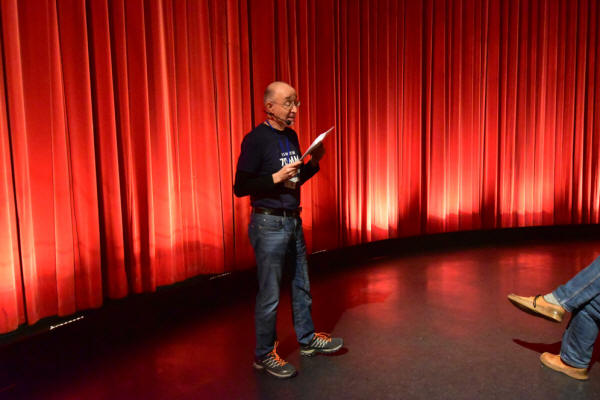 Im
Namen des Schauburg Cinerama Filmtheaters hier in Karlsruhe darf ich Sie
ganz herzlich zur 16. Ausgabe unseres Todd-AO 70mm Filmfestivals
begrüßen! Im
Namen des Schauburg Cinerama Filmtheaters hier in Karlsruhe darf ich Sie
ganz herzlich zur 16. Ausgabe unseres Todd-AO 70mm Filmfestivals
begrüßen!Im Namen des Schauburg Cinerama Filmtheaters hier in Karlsruhe darf ich Sie ganz herzlich zur 16. Ausgabe unseres Todd-AO 70mm Filmfestivals begrüßen! Es ist mir eine Ehre nach nunmehr zwei Jahren ohne dieses ikonische Festival wieder hier vorne stehen zu dürfen, um die Filme anzumoderieren. Mein Name ist Wolfram Hannemann, ich bin Filmemacher und Filmjournalist und werde meine Einführungen in alter Tradition teils auf Deutsch, teils auf Englisch halten, aber immer mit einem netten schwäbischen Touch. Welcome to the 2022 edition of your favorite film festival here at the Schauburg Cinerama theatre in Karlsruhe – the 16th Todd-AO 70mm film festival. After having been absent for two years due to the Covid pandemic it feels so good to be back. As always we will have a very diverse program on this long weekend. And let me tell you that most of it will be in full color! In case you are a fan of magenta colored prints you shouldn't worry because we will show some of those, too. During this prolonged weekend we will learn a lot of things. George Kennedy as Joe Patroni will teach us that it only needs a cigar you can chew on to solve any problem. Reg Park as Hercules will teach us that you can always lie down and relax while saving captive women. And Gal Gadot as Wonder Woman will teach us that it only needs a brave girl to save the world. And much more. My name is Wolfram Hannemann. I am a filmmaker and film journalist and will be the anchorman for this festival giving you some inside information before most of our films. Some parts I will tell in German, others only in English, but always with a nice Swabian accent. |
More in 70mm reading: Wolfram Hannemanns's in70mm.com Library Todd-AO Festival Home • 16. Todd-AO Festival • Welcome | 2022 Todd-AO Festival Flyer • Festival Images Festival Archives • Festival Through the Years • Festival Schedule and Archive • More Schauburg Cinerama Festivals in Pictures • Schauburg Cinerama • Best of Todd-AO Festival • Guests | Billboards | Posters Internet link: • Schauburg.de • Ticket reservation Filmtheater Schauburg Att: Herbert Born Marienstraße 16 76137 Karlsruhe Germany Wolfram Hannemann Talstr. 11 70825 Korntal Germany Fon: +49 (0) 711 832188 Fax: +49 (0) 711 8380518 |
Onkel Toms Hütte | |
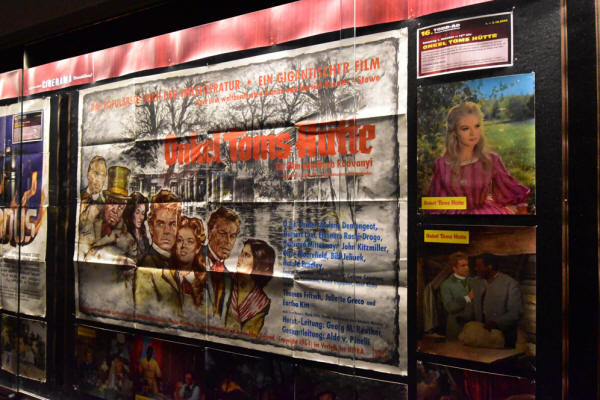 ONKEL TOMS HÜTTE entstand 1965 als
Coproduktion zwischen Debora Film (Rom), Melodie-Film GmbH (Berlin) und
SIPRO (Paris) in Zusammenarbeit mit Avala-Film (Belgrad) unter Regie von
Geza von Radvanyi. Federführender Produzent war der 1912 in Italien
geborene Aldo von Pinelli, der auch die Liedtexte für ONKEL TOMS HÜTTE
beisteuerte. Gefilmt wurde auf 65mm Negativfilm im MCS 70 Superpanorama
Format. Produzent Von Pinelli realisierte nach ONKEL TOMS HÜTTE noch
eine weitere Großproduktion in MCS 70 Superpanorama - DER KONGRESS
AMÜSIERT SICH - bevor er dann 1967 im Alter von nur 55 Jahren in München
verstarb. ONKEL TOMS HÜTTE entstand 1965 als
Coproduktion zwischen Debora Film (Rom), Melodie-Film GmbH (Berlin) und
SIPRO (Paris) in Zusammenarbeit mit Avala-Film (Belgrad) unter Regie von
Geza von Radvanyi. Federführender Produzent war der 1912 in Italien
geborene Aldo von Pinelli, der auch die Liedtexte für ONKEL TOMS HÜTTE
beisteuerte. Gefilmt wurde auf 65mm Negativfilm im MCS 70 Superpanorama
Format. Produzent Von Pinelli realisierte nach ONKEL TOMS HÜTTE noch
eine weitere Großproduktion in MCS 70 Superpanorama - DER KONGRESS
AMÜSIERT SICH - bevor er dann 1967 im Alter von nur 55 Jahren in München
verstarb. ONKEL TOMS HÜTTE erlebte seine Weltpremiere am 14. April 1965 im Münchener Mathäser Filmpalast. Interessanterweise wurde der Film in den USA erst vier Jahre nach seiner Weltpremiere in die Kinos gebracht. Und das in einer um 42 Minuten gekürzten Fassung und nur im 35mm CinemaScope-Format mit 4-Kanal-Magnetton. Mit der Kameraarbeit für ONKEL TOMS HÜTTE wurde Heinz Hölscher betraut, der dafür mit dem Filmband in Gold ausgezeichnet wurde. Hölscher, den wir 2008 als Ehrengast beim Todd-AO 70mm Filmfestival begrüßen durften, verstarb am 07. Mai 2021 im Alter von 95 Jahren. Ihn wollen wir mit der heutigen Filmvorführung ehren. Denn er war einer der ganz Großen des deutschen Films. Ob es TODESSCHÜSSE AM BROADWAY waren oder MAIGRET UND SEIN GRÖSSTER FALL, ob es HEINTJE, JOSEFINE MUTZENBACHER, DER ÖLPRINZ oder FANNY HILL waren – Hölschers Arbeit als Kameramann umspannte fünf Jahrzehnte deutscher Filmgeschichte. 1925 als Sohn eines Fabrikanten für fotografische Spezialgeräte in München geboren, ließ sich Hölscher zum Fotografen ausbilden und arbeitete anschließend in der Reprotechnik. Im Jahr 1948 wurde er Kameraassistent. Als der erfahrene Kameramann Franz Weymayr bei den Dreharbeiten zu ZWEI MENSCHEN erkrankte, musste Hölscher den Film alleine beenden. 1954 fungierte er bei der Verfilmung des Soldatenromans „08/15“ erstmals als Chefkameramann. Schon früh wird sein Gespür für den Einsatz des Lichtes gelobt, das besonders beim Schwarzweissfilm von großer Bedeutung war. Vor allem in den sechziger und siebziger Jahren war Hölscher einer der meistbeschäftigten Kameraleute des bundesdeutschen Unterhaltungskinos. Er arbeitete dabei mit Regisseuren wie Alfred Weidenmann, Alfred Vohrer, Harald Reinl und Franz Josef Gottlieb zusammen. Später stand er auch für mehrere Fernsehserien wie „Derrick“, „Tatort“ und „Ein Schloss am Wörthersee“ hinter der Kamera. UNCLE TOM'S CABIN from 1965 was the second of three films to be shot by Director of Photography Heinz Hölscher in the MCS 70 Superpanorama process which utilzes 65mm negative film. Hölscher pioneered the system as one of five cameramen with the 1962 release of FLYING CLIPPER, the first German film to be released in 70mm. Shortly after UNCLE TOM'S CABIN Hölscher used the MCS 70 process once again – for the lavish production of CONGRESS OF LOVE. With today's screening of the German dubbed version of UNCLE TOM'S CABIN we pay tribute to one of the best DoPs we ever had in Germany. Some of you might remember him being our guest of honor during our festival in 2008. Heinz Hölscher died on May 7, 2021, at the age of 95. Although the print we are running is faded, it still showcases Hölscher's camera work. |
|
Exodus | |
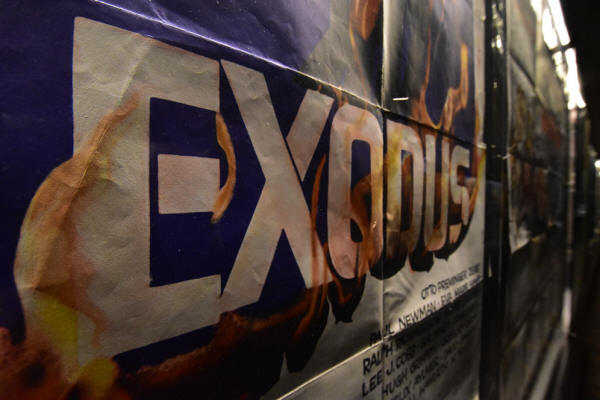 EXODUS entstand unter Regie von Otto
Preminger nach dem Roman von Leon Uris. Keinen Geringeren als Dalton
Trumbo ließ Preminger das Drehbuch schreiben und half damit, dessen
durch Hollywoods berüchtigte „Schwarze Liste“ entstandene Brandmarkung
endlich zu beenden. EXODUS entstand unter Regie von Otto
Preminger nach dem Roman von Leon Uris. Keinen Geringeren als Dalton
Trumbo ließ Preminger das Drehbuch schreiben und half damit, dessen
durch Hollywoods berüchtigte „Schwarze Liste“ entstandene Brandmarkung
endlich zu beenden. Mit einem geschätzten Budget von 4 Millionen US-Dollar wurde EXODUS von März bis Juli 1960 unter anderem in Israel und auf Zypern gedreht. Und das alles im 65mm Super Panavision Format, damals noch als „Panavision 70“ bezeichnet. Es war der erste Film, für den Reservierungen für Premierenkarten bereits am Tag des Drehbeginns zum Verkauf angeboten wurden. Im August 1960, also vier Monate vor seiner Premiere, hatte der Film durch den Kartenvorverkauf bereits über 400.000 US-Dollars generiert. Im Juli 1961 wurde EXODUS zum ersten Mal in Israel gezeigt, und der damalige Premierminister David Ben-Gurion befand ihn als "einen sehr beeindruckenden Film, wenn auch nicht immer akkurat und ein bisschen zu lang“. Mit der Länge von weit über drei Stunden hatte auch der Komiker Mort Sahl Probleme. Es wird berichtet, dass er während der Premiere, als sich der Film der dritten Stunde näherte und das Ende noch nicht abzusehen war, sich von seinem Platz im vollbesetzten Kino erhob und rief: "Otto – let my people go““, also „Otto - lassen Sie meine Leute gehen!" Der Vorfall schrieb Hollywood-Geschichte. Auch wenn viele Kritiker der Meinung waren, dass Paul Newman für die Rolle des Ari Ben Canaan eine Fehlbesetzung sei, so blieb Preminger dabei, dass er ihn bereits beim Lesen des Buches in dieser Rolle sah. Newman, der die Rolle zu Ehren seines Vaters, der Jude war, angenommen hatte, verstand sich mit Preminger nicht sonderlich gut, weil er Newmans Vorschläge und Ideen nicht hören wollte. Newman sagte später einmal, dass er es bedauere, sich auf diesen Film eingelassen zu haben. Der Film war in drei Kategorien für den Oscar nominiert, gewann ihn aber nur für die beste Filmmusik. Ernest Golds Hauptthema avancierte sogar zum Hit und wurde von vielen Künstlern eingespielt. Es wird berichtet, dass Arnold Schwarzenegger das Thema immer wieder für seine Posing Routine verwendete. Das Thema fand sogar Einzug in die Hip-hop Musik und wurde von Musikern wie Ice-T in ihren Songs verwendet. Und hier noch zwei Fun Facts: Nummer 1: Für die Szene, in der Gefangene aus dem alten Gefängnis in Acre ausbrechen, wurden 250 Statisten angeheuert, um die Gefangenen zu spielen. Am Ende zählte man jedoch 253 Statisten. Es stellte sich heraus, dass es sich bei den drei zusätzlichen Statisten um echte Ausbrecher handelte, die aus einer nahegelegenen Psychiatrie ausgebüxt waren Nummer 2: In einer Nebenrolle ist erstmals die später berühmte Sängerin Esther Reichstadt (bekannt geworden als Esther Ofarim) als Mrs. Hirschberg zu sehen. |
|
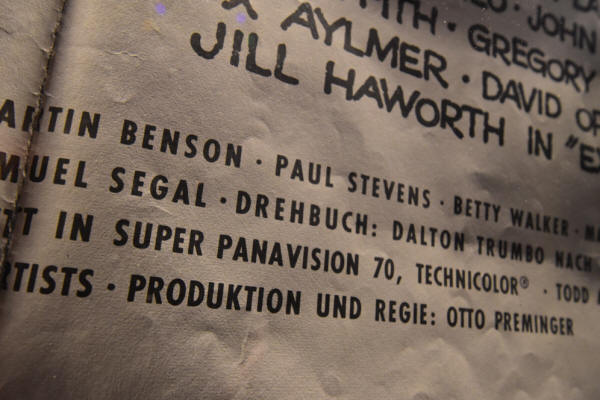 Dore Schary, who had been the MGM studio production head, had
commissioned „Exodus“ as an original screenplay written by Leon Uris,
intending to produce it. With Schary’s departure from the studio in
October 1956, the studio lost interest in the project and Uris used the
material to create his novel. When Otto Preminger read a draft of
„Exodus“ and learned that the rights were held by MGM, he met with them
and suggested that if they produced the film they would likely suffer
boycotts from Arab countries that he, as an independent producer, would
avoid. According to Preminger, concern over a potential boycott
motivated MGM's sale of the property. Dore Schary, who had been the MGM studio production head, had
commissioned „Exodus“ as an original screenplay written by Leon Uris,
intending to produce it. With Schary’s departure from the studio in
October 1956, the studio lost interest in the project and Uris used the
material to create his novel. When Otto Preminger read a draft of
„Exodus“ and learned that the rights were held by MGM, he met with them
and suggested that if they produced the film they would likely suffer
boycotts from Arab countries that he, as an independent producer, would
avoid. According to Preminger, concern over a potential boycott
motivated MGM's sale of the property. In May 1958 United Artists and Preminger purchased the rights to the Leon Uris novel set to be published the following September. Upon its publication, the novel became an immediate best seller, remaining on the best-seller list for eighty weeks. Writing credits for the screenplay for EXODUS became intertwined in the larger issue of the Hollywood Blacklist. First blacklisted writer Albert Maltz was rumored to be writing the script for EXODUS, but in January 1960 Preminger announced that another blacklisted writer, Dalton Trumbo, had been set to write the screenplay. Preminger initially started work on a script with Uris, but the author could not make the adjustment between novel and script writing and so was fired. Preminger hired Maltz to complete the script, but the writer never got past the research stage. Like Maltz, Trumbo was a member of the “Hollywood Ten” and had served eleven months in jail in 1950 for contempt of Congress. Using pseudonyms, Trumbo had continued writing scripts and had won an Academy Award under one of his pseudonyms, Robert Rich, for THE BRAVE ONE (1956). After years of confusion and rumors over Rich’s identity, when the Academy repealed its blacklist bylaw in January 1959, Trumbo identified himself as the film’s writer. Despite his admission, Trumbo was not openly publicized as the writer for Universal’s SPARTACUS until February 1960, after Preminger’s public hiring of him for EXODUS. Anticipating protests over Trumbo’s participation in EXODUS, United Artists announced that Preminger had full autonomy in deciding on the screenwriter. Throughout February 1960 the American Legion campaigned against Trumbo’s participation in EXODUS and SPARTACUS. In late February, the Screen Publicists Guild protested the “interference by the American Legion in the private employer-employee relationships of the film industry“. In May 1960, a New York Post article stated that Trumbo had been “fired” as the writer of the EXODUS screenplay. Preminger’s assistant is quoted as stating that “the Hearst Press had been conducting a campaign against Hollywood rehiring of the writers who had been blacklisted” and that, at any rate, it was impossible to fire Trumbo as the screenplay was “being employed in the filming now taking place in Israel.” After 1960, both Preminger and SPARTACUS producer-star Kirk Douglas claimed credit for being the first to “break the blacklist” by restoring Trumbo’s onscreen credit. SPARTACUS was released two months prior to EXODUS. We will present EXODUS in a faded 70mm print with German dubbed 6-track magnetic stereophonic sound. |
|
Tenet | |
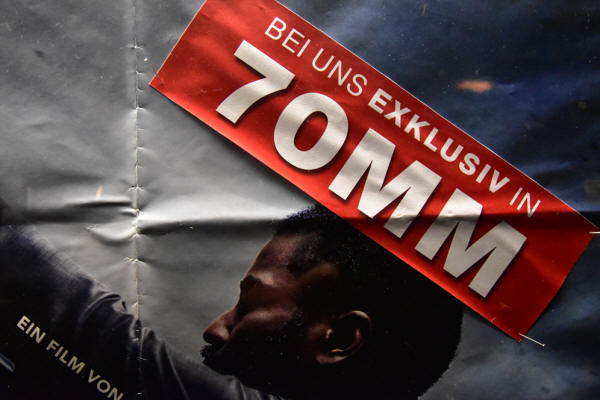 Eigentlich hätte Sie hier unser sehr
geschätzter Kollege und Kameramann Orla Vestergaard Nielsen begrüßen und
Ihnen von den Dreharbeiten zu TENET in Dänemark erzählen sollen, die als
Testfeld für die neue Magellan 65 Kamera von Logmar genutzt wurden, aber
leider ist Orla erkrankt und sein Arzt hat ihm das Reisen verboten. Ich
wünsche Orla von dieser Stelle aus alsbaldige Genesung und werde
versuchen, ihn würdig zu vertreten. Eigentlich hätte Sie hier unser sehr
geschätzter Kollege und Kameramann Orla Vestergaard Nielsen begrüßen und
Ihnen von den Dreharbeiten zu TENET in Dänemark erzählen sollen, die als
Testfeld für die neue Magellan 65 Kamera von Logmar genutzt wurden, aber
leider ist Orla erkrankt und sein Arzt hat ihm das Reisen verboten. Ich
wünsche Orla von dieser Stelle aus alsbaldige Genesung und werde
versuchen, ihn würdig zu vertreten. Ich weiß jetzt nicht wie viele von Ihnen den Film schon gesehen haben, darf Ihnen aber jetzt schon versprechen, dass Christopher Nolans TENET Sie fordern wird – sowohl inhaltlich wie auch optisch und akustisch. Schon vorab ein Trost an alle, die den Film heute zum ersten Mal sehen: es ist schier unmöglich ihn beim ersten Mal in allen Einzelheiten zu begreifen. Aber das ist gut so, sorgt er doch für reichlich Gesprächsstoff beim traditionellen „Get Together“ im Foyer nach dem Film. Der Titel des Films ist ein Palindrom, also ein Wort, das vorwärts und rückwärts gelesen genau gleich lautet, und damit quasi eine Metapher für das Thema des Films darstellt. Denn darin wird das Konzept der Zeitumkehr verwendet, was bedeutet, dass die Figuren, um zehn Tage in der Zeit zurück zu einem bestimmten Ereignis zu gelangen, zehn Tage in der umgekehrten Zeit verbringen müssen, um dort anzukommen. Im gesamten Film wird die Farbe Rot verwendet, um die voranschreitende Zeit anzuzeigen, und Blau, um eine Zeitumkehr anzuzeigen. Dies ist eine Anspielung auf den Dopplereffekt, bei dem Lichtkörper, die sich von der Erde entfernen, rot erscheinen, da die Lichtwellen nach außen gestreckt werden, und Lichtkörper, die sich auf die Erde zubewegen, blau erscheinen, da die Lichtwellen zusammengedrückt werden. Nolan nutzte in TENET keine Greenscreens, sondern setzte auf praktische Effekte. Dies gilt auch für die Inversionssequenzen, für die jede Szene zweimal gedreht werden musste: einmal mit den Schauspielern, die sich vorwärts bewegen, und einmal mit ihnen, die alles rückwärts machen. Eigens für den Film wurden Ausrüstungen und Objektive angefertigt, die einen verstärkten Einsatz von IMAX-Kameras ermöglichten. So wurde beispielsweise ein spezieller Kamerakopf gebaut, der in ein Auto passt und mit dem eine IMAX-Kamera um 360 Grad gedreht werden kann. Es wurden auch Objektive konstruiert, die es den Filmemachern ermöglichten, bei schwächerem Licht zu drehen, was bei IMAX-Kameras traditionell nur eingeschränkt möglich ist. Was den Ton angeht, so gab es nach dem Kinostart des Films viele Beschwerden, man könne die Dialoge oft nicht verstehen. Kein Fehler – Nolan wollte es genau so, es war seine künstlerische Entscheidung. Doch ich darf Sie beruhigen: wir zeigen den Film heute Abend zumindest mit deutschen Untertiteln, was der Dialogverständlichkeit entgegenkommt. Time is one of the recurring subjects in the films of Christopher Nolan. In MEMENTO (2000) he tells the story of a man suffering from short-term memory loss and thus edited his film in a very unusual way. The film's nonlinear narrative is presented as two different sequences of scenes interspersed during the film: a series in black-and-white that is shown chronologically, and a series of color sequences shown in reverse order (simulating for the audience the mental state of the protagonist). The two sequences meet at the end of the film, producing one complete and cohesive narrative. In INCEPTION (2010) Nolan demonstrated the apparent slowing of time when dreaming. In his sci-fi epic INTERSTELLAR (2014), which we presented in this festival in 2015, Nolan demonstrates the relativity of time and the spacetime warp in a very effective way. And in TENET (2020) which you are going to see tonight, Nolan invents objects with "inverted" entropy, meaning they move backward through time. The film follows a CIA agent who learns how to manipulate the flow of time to prevent an attack from the future that threatens to destroy the present world. Nolan took more than five years to write the screenplay after deliberating about TENET's central ideas for over a decade. Pre-production began in late 2018, casting took place in March 2019, and principal photography lasted six months, from May to November, in Denmark, Estonia, India, Italy, Norway, the United Kingdom, and the United States. Cinematographer Hoyte van Hoytema shot on 65mm film and IMAX 15/70, as he did before in INTERSTELLAR and DUNKIRK and just now on NOPE. About 1.6 million feet of IMAX footage was shot for the film, breaking director Christopher Nolan's own record. There was much secrecy surrounding the project before its release. Actor Robert Pattinson said that he was only allowed to read the script in a locked office at Warner Bros. studios. His co-star Michael Caine wasn't even allowed to read the entire screenplay. He was given his scenes only to read before shooting. Prior to the movie's release, Caine told press that he had no idea what the film was about, despite being a very close friend and a frequent collaborator of director Christopher Nolan. In addition to performing stunts backwards, the main cast actually learned how to speak in reverse for their roles. Sir Kenneth Branagh not only learned how to speak backwards, but also had to do it with his character's Russian accent. Speaking of Sir Kenneth Branagh it is interesting to note that he most likely appeared in more 65mm productions than any other actor. We saw him in HAMLET, DUNKIRK, MURDER ON THE ORIENT EXPRESS, DEATH ON THE NILE, TENET and will see him in the forthcoming OPPENHEIMER. TENET is the first Nolan film since THE PRESTIGE (2006) not to be scored by Hans Zimmer. The composer turned Nolan down for the first time in over a decade to score his longtime passion project DUNE (2021). He was replaced by newcomer Ludwig Göransson, who had previousely won an Oscar for his work on BLACK PANTHER. Göransson incorporated director Christopher Nolan's own breathing as a part of the soundtrack used around Kenneth Branagh's villainous character. The sound was achieved by Nolan breathing heavily into a microphone, and Göransson manipulating that into uncomfortable and raspy sounds. In order to achieve certain in-camera effects, IMAX worked with the filmmakers to rebuild mechanics and electronics in their cameras to enable them to shoot both backwards and forwards. The production also utilized the latest generation of what are called "blimps" - sound-reducing housings for the notoriously noisy cameras - which allowed more scenes to be shot using the format. By the way: Christopher Nolan cited one of my favorite movies, TO LIVE AND DIE IN L.A. (1985), as one of the inspirations for the elaborate car chase sequence, mainly the way the camera sits with the characters and takes the audience through the chase. And now, ladies and gentlemen, get ready for a stunning audio visual experience in 70mm. And be warned: it is geting very loud! |
|
Hercules and the Captive Women | |
 HERKULES EROBERT ATLANTIS entstand 1961
unter Regie von Vittorio Cottafavi. Cottafavi (getauft auf den Namen
Benedetto Vittorio Emmanuele Secondo), wurde am 30. Januar 1914 in
Modena, Italien, als Sohn eines Offiziers und Landbesitzers geboren. Er
verfügte bereits über eine Universitätsausbildung in Jura, Philosophie
und Literatur, als er 1938 sein Studium am berühmten Centro Sperimentale
di Cinematografia in Rom abschloss. Seine berufliche Laufbahn in der
Filmindustrie begann er als Clapper Boy. Nachdem er Drehbücher für
Kinofilme geschrieben und als Regieassistent unter Alessandro Blasetti
und Vittorio De Sica gearbeitet hatte, wurde er 1943 selbständiger
Regisseur. Viele seiner Filme wurden aufwändig produziert, darunter
mehrere augenzwinkernde Kostümspektakel mit "Schwert und Sandalen", die
sich mit mythologischen Themen befassen und meist das Römische Reich
oder das alte Ägypten zum Thema haben. Ab Mitte der 60er Jahre
konzentrierte sich Cottafavi ausschließlich auf die Regie von
Fernsehserien und Miniserien im Auftrag der RAI (Radio Televisione
Italiana). Cottafavi starb am 14. Dezember 1998 in Anzio, Italien. HERKULES EROBERT ATLANTIS entstand 1961
unter Regie von Vittorio Cottafavi. Cottafavi (getauft auf den Namen
Benedetto Vittorio Emmanuele Secondo), wurde am 30. Januar 1914 in
Modena, Italien, als Sohn eines Offiziers und Landbesitzers geboren. Er
verfügte bereits über eine Universitätsausbildung in Jura, Philosophie
und Literatur, als er 1938 sein Studium am berühmten Centro Sperimentale
di Cinematografia in Rom abschloss. Seine berufliche Laufbahn in der
Filmindustrie begann er als Clapper Boy. Nachdem er Drehbücher für
Kinofilme geschrieben und als Regieassistent unter Alessandro Blasetti
und Vittorio De Sica gearbeitet hatte, wurde er 1943 selbständiger
Regisseur. Viele seiner Filme wurden aufwändig produziert, darunter
mehrere augenzwinkernde Kostümspektakel mit "Schwert und Sandalen", die
sich mit mythologischen Themen befassen und meist das Römische Reich
oder das alte Ägypten zum Thema haben. Ab Mitte der 60er Jahre
konzentrierte sich Cottafavi ausschließlich auf die Regie von
Fernsehserien und Miniserien im Auftrag der RAI (Radio Televisione
Italiana). Cottafavi starb am 14. Dezember 1998 in Anzio, Italien.Chefkameramann des in Super Technirama 70 aufgenommenen HERKULES EROBERT ATLANTIS war Carlo Carlini. Carlini erlernte sein Handwerk ab 1936, als er zunächst als Kameraassistent und anschließend als einfacher Kameramann unter der Anleitung des Chefkameramanns Otello Martelli arbeitete. Kurz nach dem Zweiten Weltkrieg ist er als ausführender Kameramann bei den bekannten Produktionen GRAF CAGLIOSTRO und DIE MAUERN VON MALAPAGA nachzuweisen. Seit 1949 als Chefkameramann tätig, stand Carlini bei fast 300 Filmen hinter der Kamera und kooperierte mit einer Fülle von Regisseuren, darunter einige wenige namhafte wie Federico Fellini, Roberto Rossellini und Luigi Comencini. Für seine Kameraleistung zu dem im Venedig des 16. Jahrhunderts spielenden Historiendrama IN KETTEN ZUM SCHAFOTT erhielt Carlo Carlini 1964 die Nominierung für das Silberne Band. Das Gros von Carlinis Arbeiten ist jedoch wenig ambitionierte Unterhaltungsware, inszeniert von Routiniers wie Duccio Tessari, Stefano Vanzina, Marcello Baldi, Umberto Lenzi und Domenico Paolella. Dabei erwies sich der gebürtige Römer mit seiner Arbeit als genreübergreifend und stand sowohl bei Romanzen, Softsexplotten, Kostüm- und Abenteuerfilmen als auch bei Antik- und Melodramen, Agentenstreifen, Kriegsfilmen sowie einigen Italowestern hinter der Kamera. 1988 verschwand Carlo Carlini aus dem Blickfeld der Öffentlichkeit. Wir zeigen HERKULES EROBERT ATLANTIS in der deutschen Fassung mit einer 70mm- Erstaufführungskopie. Die Farben sind leider verblasst und der Magnetton gibt sich nur monophon, aber die Bildschärfe wird Sie begeistern. Now let me tell you a bit about Reg Park, who plays Hercules in our next feature presentation, HERCULES AND THE CAPTIVE WOMEN, as it was titled in the USA. |
|
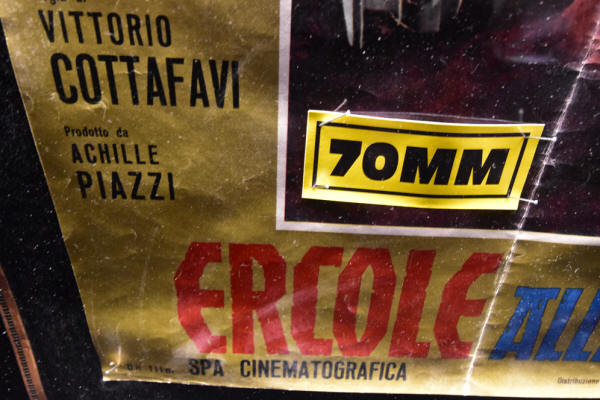 The future Italian epic star was registered as Roy Park in 1928, but
little Reg was soon re-named after his father Reginald Park Snr., owner
of the Reg Park Barbell Company in Leeds. Reg Jnr. played reserve team
football for Leeds United before turning to body-building in 1946. He
finished Mr Universe runner-up to future film rival Steve Reeves in
1950, then won the title outright in 1951, 1958 and 1965. After marrying
South African-born Mareon Isaacs in Johannesburg in 1952, the Parks
moved permanently to South Africa where Reg ran a chain of fitness
studios. In December 1960 he was invited to Rome to star in two
back-to-back Hercules movies, HERCULES AND THE CAPTIVE WOMEN followed
immediately by HERCULES IN THE HAUNTED WORLD. Since these were directed
by intellectually acclaimed veterans Vittorio Cottafavi and Mario Bava,
Reg Park himself became something of a cult personality in the Italian
epic genre. His friend and protege Arnold Schwarzenegger considered Park
to be the best of the "peplum" heroes. Arnold trained with him in the
late 60s and actually lived with him and his family for a time in their
home in South Africa. It was he who urged Arnold into taking the
HERCULES IN NEW YORK film role as a money-making proposition in 1970. The future Italian epic star was registered as Roy Park in 1928, but
little Reg was soon re-named after his father Reginald Park Snr., owner
of the Reg Park Barbell Company in Leeds. Reg Jnr. played reserve team
football for Leeds United before turning to body-building in 1946. He
finished Mr Universe runner-up to future film rival Steve Reeves in
1950, then won the title outright in 1951, 1958 and 1965. After marrying
South African-born Mareon Isaacs in Johannesburg in 1952, the Parks
moved permanently to South Africa where Reg ran a chain of fitness
studios. In December 1960 he was invited to Rome to star in two
back-to-back Hercules movies, HERCULES AND THE CAPTIVE WOMEN followed
immediately by HERCULES IN THE HAUNTED WORLD. Since these were directed
by intellectually acclaimed veterans Vittorio Cottafavi and Mario Bava,
Reg Park himself became something of a cult personality in the Italian
epic genre. His friend and protege Arnold Schwarzenegger considered Park
to be the best of the "peplum" heroes. Arnold trained with him in the
late 60s and actually lived with him and his family for a time in their
home in South Africa. It was he who urged Arnold into taking the
HERCULES IN NEW YORK film role as a money-making proposition in 1970.At age 42, he competed against Arnold Schwarzenegger in a 1970 body-building contest and was edged out in a closely fought contest - losing the Mr. Universe title to Schwarzenegger by only half a point. Coming to an end I have two fun facts for you: Number 1: For the Woolner Brothers U.S. release version, under the title HERCULES AND THE CAPTIVE WOMEN, the original score has been replaced by a stock score selected by Gordon Zahler. Zahler used much of the same music he had selected for the U.S. release of Kurt Maetzig's FIRST SPACESHIP ON VENUS (1962) as well as portions of the score from Jack Arnold's CREATURE FROM THE BLACK LAGOON. Number 2: Material from HERCULES AND THE CAPTIVE WOMEN was edited into another Reg Park film titled HERCULES THE AVENGER in 1966. And now, ladies and gentlemen, let us give way for a lot of muscles in Pinkorama and the razor sharpness of Super Technirama 70. |
|
Spartacus | |
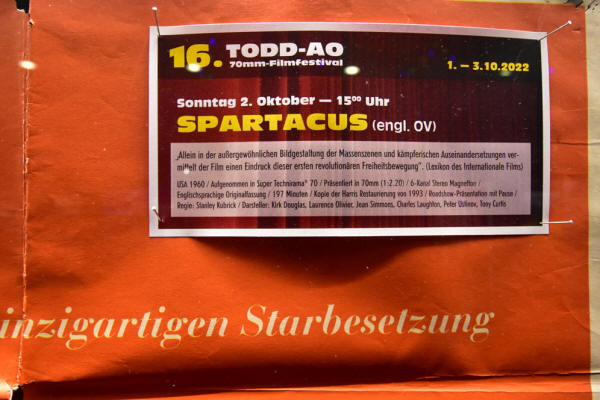 Bei der Version von SPARTACUS, die Sie
gleich im Anschluss sehen werden, handelt es sich um die von Robert A.
Harris 1991 restaurierte Fassung. Da das Original Kameranegativ von
SPARTACUS mehrfach gekürzt wurde und zudem keine Farben mehr hatte,
erstellte Harris ein neues 65mm Negativ unter Zuhilfenahme der Original
Farbmatrizen. Auch fügte er wieder Szenen ein, welche nach der Premiere
des Films im Jahre 1960 entfernt wurden, da sie für die damalige Zeit
offensichtlich zu anrüchig oder zu brutal waren. Eine dieser Szenen ist
jene, in der Laurence Olivier alias Crassus seinen Sklaven Tony Curtis
alias Antonius verführen will. Der Originalton für diese Sequenz war
unwiderruflich zerstört und die Szene musste daher für die restaurierte
Fassung neu synchronisiert werden. Tony Curtis war verfügbar, Laurence
Olivier jedoch starb schon zwei Jahre zuvor. Da erinnerte sich Mrs.
Olivier daran, dass Anthony Hopkins einmal ihren Mann imitierte. Man
trat an Hopkins heran und konnte ihn für die Synchro gewinnen. Daher
auch die Danksagung an Anthony Hopkins im Abspann der restaurierten
Fassung des Films. Bei der Version von SPARTACUS, die Sie
gleich im Anschluss sehen werden, handelt es sich um die von Robert A.
Harris 1991 restaurierte Fassung. Da das Original Kameranegativ von
SPARTACUS mehrfach gekürzt wurde und zudem keine Farben mehr hatte,
erstellte Harris ein neues 65mm Negativ unter Zuhilfenahme der Original
Farbmatrizen. Auch fügte er wieder Szenen ein, welche nach der Premiere
des Films im Jahre 1960 entfernt wurden, da sie für die damalige Zeit
offensichtlich zu anrüchig oder zu brutal waren. Eine dieser Szenen ist
jene, in der Laurence Olivier alias Crassus seinen Sklaven Tony Curtis
alias Antonius verführen will. Der Originalton für diese Sequenz war
unwiderruflich zerstört und die Szene musste daher für die restaurierte
Fassung neu synchronisiert werden. Tony Curtis war verfügbar, Laurence
Olivier jedoch starb schon zwei Jahre zuvor. Da erinnerte sich Mrs.
Olivier daran, dass Anthony Hopkins einmal ihren Mann imitierte. Man
trat an Hopkins heran und konnte ihn für die Synchro gewinnen. Daher
auch die Danksagung an Anthony Hopkins im Abspann der restaurierten
Fassung des Films.Eine der ganz besonderen Zutaten bei SPARTACUS - und da werden mir Filmmusikfreunde sicherlich zustimmen - ist die Partitur des 1991 im Alter von 81 Jahren verstorbenen Alex North. Seiner außergewöhnlichen Musik zuliebe ließ Kubrick sogar Dialoge und Geräusche in den Hintergrund treten, um dadurch eine noch bessere Dynamik zu erreichen. North wurde für SPARTACUS mit einer Oscar-Nominierung bedacht. Der Oscar selbst ging in jenem Jahr jedoch an Ernest Gold für EXODUS. Norths Musik, die vom American Film Institute für die Liste der besten Filmmusiken nominiert wurde, ist ein Paradebeispiel dafür, wie modernistische Kompositionsstile an die Hollywood-Leitmotivtechnik angepasst werden können. Norths Partitur ist episch, wie es dem Ausmaß des Films entspricht. Nach umfangreichen Recherchen über die Musik dieser Zeit stellte North eine Sammlung antiker Instrumente zusammen, die zwar nicht authentisch römisch sind, aber eine starke dramatische Wirkung haben. Zu diesen Instrumenten gehörten ein Sarrusophon, eine israelische Blockflöte, eine chinesische Oboe, eine Laute, eine Mandoline, eine jugoslawische Flöte, eine Kythara, ein Hackbrett und ein Dudelsack. Norths Instrument der Wahl war die Ondioline, die einer früheren Version des elektronischen Synthesizers ähnelt und zuvor noch nie für einen Film verwendet wurde. Ein großer Teil der Musik ist ohne Tonika geschrieben oder kokettiert mit der Tonalität in einer Weise, die die meisten Filmkomponisten nicht riskieren würden. Ein Thema wird sowohl für die Sklaverei als auch für die Freiheit verwendet, erhält aber in verschiedenen Szenen unterschiedliche Lautwerte, so dass es wie verschiedene Themen klingt. Das Liebesthema für Spartacus und Varinia ist das zugänglichste Thema im Film, und für Crassus wurde eine harte Trompetenfigur geschaffen. Bei der Kopie, die wir Ihnen zeigen, handelt es sich um Universals Archivkopie von 1993, die über 6-Kanal Dolby SR Magnetton verfügt, der Norths Musik zugute kommen dürfte. The development of SPARTACUS was partly instigated by Kirk Douglas's failure to win the title role in William Wyler's BEN-HUR. Douglas had worked with Wyler before on DETECTIVE STORY, and was disappointed when Wyler chose Charlton Heston, instead. Shortly after, Edward Lewis, a vice president in Douglas's film company, Bryna Productions, had Douglas read Howard Fast's novel, „Spartacus“, which had a related theme - an individual who challenges the might of the Roman Empire - and Douglas was impressed enough to purchase an option on the book from Fast with his own finances. Universal Studios eventually agreed to finance the film after Douglas persuaded Laurence Olivier, Charles Laughton, and Peter Ustinov to act in it. Olivier was also to direct the picture. Lewis became the producer of the film, with Douglas taking executive producer credit. Douglas originally offered the role of Varinia to French actress Jeanne Moreau, but she didn't want to leave her boyfriend in France. German actress Sabine Bethmann was then cast. The studio gave her the anglicized name of "Sabina Bethman" for use in the film's publicity. After David Lean turned down an offer to direct SPARTACUS, Anthony Mann was hired. Mann was then best known for his Westerns such as WINCHESTER 73 and THE NAKED SPUR. Douglas fired Mann at the end of the first week of shooting, during which the opening sequence in the quarry had been filmed. "He seemed scared of the scope of the picture," wrote Douglas in his autobiography, yet a year later, Mann would embark on another epic of similar size, EL CID. The dismissal (or resignation) of Mann is mysterious since the opening sequences, filmed at Death Valley, California, set the style for the rest of the film. |
|
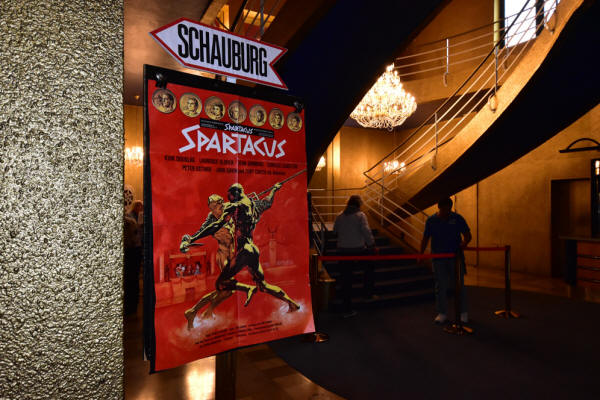 Thirty-year-old Stanley Kubrick was hired to take over. He had already
directed four feature films (including PATHS OF GLORY, also starring
Douglas). SPARTACUS was a bigger project by far, with a budget of $12
million (equivalent to about $112 million in today's funds) and a cast
of 10,500, a daunting project for such a young director. Kubrick
immediately fired Sabine Bethmann, who had only worked two days on the
film. He and Douglas felt that she wasn't right for the role, so she was
paid $3,000 to go home. Bethmann was replaced with Jean Simmons, who had
been campaigning for the role. Thirty-year-old Stanley Kubrick was hired to take over. He had already
directed four feature films (including PATHS OF GLORY, also starring
Douglas). SPARTACUS was a bigger project by far, with a budget of $12
million (equivalent to about $112 million in today's funds) and a cast
of 10,500, a daunting project for such a young director. Kubrick
immediately fired Sabine Bethmann, who had only worked two days on the
film. He and Douglas felt that she wasn't right for the role, so she was
paid $3,000 to go home. Bethmann was replaced with Jean Simmons, who had
been campaigning for the role.SPARTACUS was filmed using the 35mm Super Technirama 70 format and then printed to 70mm film. This was a change for Kubrick, who preferred using the standard spherical format. This new process allowed him to achieve ultra-high definition and to capture large panoramic scenes. Kubrick had wanted to shoot the picture in Rome with cheap extras and resources, but Edward Muhl, president of Universal Pictures, wanted to make an example of the film and prove that a successful epic could be made in Hollywood itself. A compromise was reached by filming the intimate scenes in Hollywood, and the battle scenes, at Kubrick's request, in Spain. Kubrick found working outdoors or in real locations to be distracting, and he believed the actors would benefit more from working on a sound stage, where they could fully concentrate. To create the illusion of the large crowds that play such an essential role in the film, Kubrick's crew used three-channel sound equipment to record 76,000 spectators at a Michigan State – Notre Dame college football game shouting "Hail, Crassus!" and "I'm Spartacus!" Disputes broke out during the filming. Cinematographer Russell Metty, a veteran with experience working in big pictures such as Orson Welles' THE STRANGER (1946) and TOUCH OF EVIL (1958) and Howard Hawks's BRINGING UP BABY (1938), complained about Kubrick's unusually precise and detailed instructions for the film's camerawork, and disagreed with Kubrick's use of light. On one occasion, he threatened to quit to Ed Muhl, to which Kubrick told him: "You can do your job by sitting in your chair and shutting up. I'll be the director of photography." Metty later muted his criticisms after winning the Oscar for Best Cinematography. So here we go – with Universal's 70mm archive print of the Harris restoration complete with 6-track Dolby SR magnetic sound. |
|
Wonder Woman | |
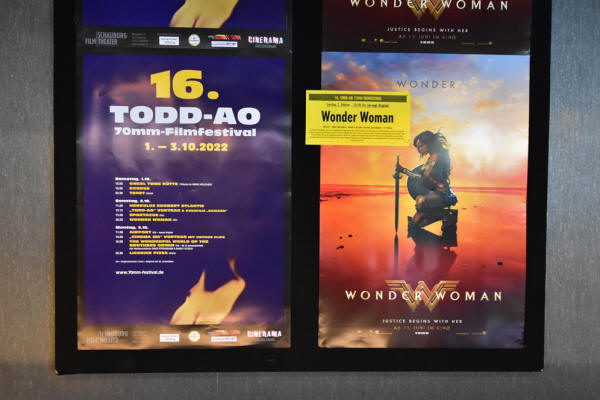 Mit WONDER WOMAN betreten wir hier im
Rahmen des 70mm Todd-AO Filmfestivals Neuland, worüber ich mich sehr
freue. Denn es ist der erste Film einer Regisseurin, den wir im Programm
haben! Patty Jenkins heisst die Dame, ist Jahrgang 1971 und gebürtige
Amerikanerin, die mit keinem Geringeren als Sir Richard Burton verwandt
ist: Ihr Vater, William Jenkins, war ein Cousin zweiten Grades von
Burton. Patty begann ihre Karriere als Kunstmalerin bei The Cooper Union
in New York City, bevor sie sich dem Filmemachen zuwandte. Acht Jahre
war sie als Kamerafrau und Focus Puller für Werbefilme und Musikvideos
tätig, bevor sie das American Film Insitute besuchte um dann schließlich
2003 ihren ersten Spielfilm MONSTER mit Charlize Theron und Christina
Ricci zu inszenieren. Für Filmkritiker Roger Ebert war MONSTER der beste
Film des Jahres 2004 und er bezeichnete ihn gar als den drittbesten Film
des Jahrzehnts. Nach dem Erfolg von MONSTER arbeitete Jenkins weiter als
Regisseurin für zahlreiche Werbe- und Fernsehfilme, darunter ARRESTED
DEVELOPMENT und ENTOURAGE. Bereits im Jahre 2005 war Patty Jenkins mit
Warner Brothers im Gespräch bezüglich eines WONDER WOMAN Films. Doch
aufgrund ihrer unerwarteten Schwangerschaft musste sie das Projekt
fallen lassen. Doch jetzt wähnt sich die Regisseurin am Ziel ihrer
Träume. Denn 2016 wurde ihr größter Wunsch, einen WONDER WOMAN Film zu
inszenieren, Wirklichkeit. Zudem stellte sie damit gleich einen neuen
Rekord auf: es war der weltweit umsatzstärkste Live Action Film in
diesem Jahr, der von einer Frau inszeniert wurde. Mit WONDER WOMAN betreten wir hier im
Rahmen des 70mm Todd-AO Filmfestivals Neuland, worüber ich mich sehr
freue. Denn es ist der erste Film einer Regisseurin, den wir im Programm
haben! Patty Jenkins heisst die Dame, ist Jahrgang 1971 und gebürtige
Amerikanerin, die mit keinem Geringeren als Sir Richard Burton verwandt
ist: Ihr Vater, William Jenkins, war ein Cousin zweiten Grades von
Burton. Patty begann ihre Karriere als Kunstmalerin bei The Cooper Union
in New York City, bevor sie sich dem Filmemachen zuwandte. Acht Jahre
war sie als Kamerafrau und Focus Puller für Werbefilme und Musikvideos
tätig, bevor sie das American Film Insitute besuchte um dann schließlich
2003 ihren ersten Spielfilm MONSTER mit Charlize Theron und Christina
Ricci zu inszenieren. Für Filmkritiker Roger Ebert war MONSTER der beste
Film des Jahres 2004 und er bezeichnete ihn gar als den drittbesten Film
des Jahrzehnts. Nach dem Erfolg von MONSTER arbeitete Jenkins weiter als
Regisseurin für zahlreiche Werbe- und Fernsehfilme, darunter ARRESTED
DEVELOPMENT und ENTOURAGE. Bereits im Jahre 2005 war Patty Jenkins mit
Warner Brothers im Gespräch bezüglich eines WONDER WOMAN Films. Doch
aufgrund ihrer unerwarteten Schwangerschaft musste sie das Projekt
fallen lassen. Doch jetzt wähnt sich die Regisseurin am Ziel ihrer
Träume. Denn 2016 wurde ihr größter Wunsch, einen WONDER WOMAN Film zu
inszenieren, Wirklichkeit. Zudem stellte sie damit gleich einen neuen
Rekord auf: es war der weltweit umsatzstärkste Live Action Film in
diesem Jahr, der von einer Frau inszeniert wurde. Mit der Israelitin Gal Gadot hat Patty Jenkins ihre Wonder Woman gefunden. Sie ist Sängerin, ausgebildete Martial Arts Kämpferin und Fotomodell. Zwei Jahre lang diente sie in der israelischen Armee und wurde 2004 zur Miss Israel gekürt. Ihr Filmdebüt gab die 1985 geborene Gal im vierten FAST AND FURIOUS Film, in welchem sie sogar ihre eigenen Stunts ausführte. Für WONDER WOMAN unterzog sich die junge Frau einem neunmonatigen, harten Training, um 17 Pfund pure Muskelmasse aufzubauen. Weil sie während eines Nachdrehs inklusive Stuntarbeit für WONDER WOMAN bereits im fünften Monat schwanger war und man ihren kleinen Babybauch bereits sehen konnte, wurde für sie eigens ein Kostüm angefertigt, das um ihren Bauch herum eine Green Screen beinhaltete, die dann während der Post Production Phase eliminiert wurde. WONDER WOMAN wurde zum überwiegenden Teil auf 35mm Negativfilm im Super 35 Verfahren aufgenommen und neben digitalen Kinofassungen in 2D, 3D und IMAX 3D in den USA auch mit einigen 70mm Kopien in die Kinos gebracht. Eine dieser Kopien, die über Datasat Digitalton verfügt, werden wir gleich im Anschluss sehen To bring WONDER WOMAN to the big screen in a big way, director Patty Jenkins surrounded herself with an amazing core team who would help her shape the look and feel of the film: director of photography Matthew Jensen, production designer Aline Bonetto, costume designer Lindy Hemming, editor Martin Walsh, and visual effects supervisor Bill Westenhofer. |
|
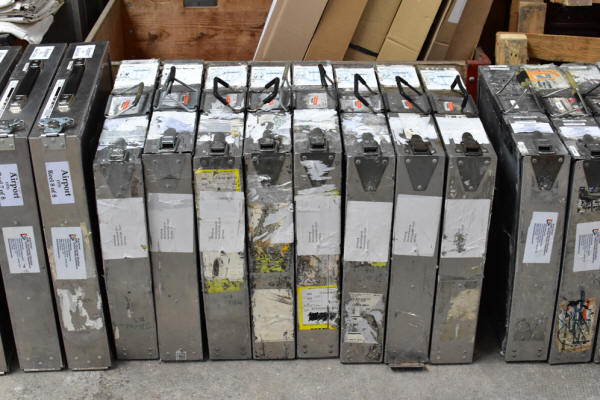 According to DoP Matthew Jensen, putting WONDER WOMAN into the time
frame was tough, because a World War I movie has a very specific visual
language, from the costumes to the production design to the lighting,
but audiences have more modern expectations for the look of a superhero
film. To make those things mesh was the challenge, to be of that time
and yet also beyond it. The filmmakers therefore decided to steer clear
of the de-saturated colors meant to evoke nostalgia, and instead feature
more intense colors and modern contrast. „We also brought wider lenses
in closer to the characters,“ Jensen explains, „which opened up the
space beyond them.“ According to DoP Matthew Jensen, putting WONDER WOMAN into the time
frame was tough, because a World War I movie has a very specific visual
language, from the costumes to the production design to the lighting,
but audiences have more modern expectations for the look of a superhero
film. To make those things mesh was the challenge, to be of that time
and yet also beyond it. The filmmakers therefore decided to steer clear
of the de-saturated colors meant to evoke nostalgia, and instead feature
more intense colors and modern contrast. „We also brought wider lenses
in closer to the characters,“ Jensen explains, „which opened up the
space beyond them.“ The cinematographer also employed numerous state-of-the-art techniques available to modern mobile cameras. „We used high crane shots, flying into low shots looking up, following Wonder Woman as she flies through the air and twists. In that regard, we were in no way limited by a classical understanding of a period film.“ One way the film avoided a modern approach was in the choice to shoot on film. „Digital is very popular,“ adds Jensen, „but it was never a question for us what format we were going to shoot on. Patty is a huge fan of film. I’m a huge fan of film. It just has a weight and a gravity that is different than digital. One is not necessarily better than the other, it’s just that there’s a different feeling with film; it’s just a different experience.“ Jenkins enlisted composer Rupert Gregson-Williams to translate into music the qualities of the Wonder Woman character as she appears in this film. „Patty and I worked together to find the themes for the movie. She has a great ear, and guided me early on toward the musical colors she felt had an affinity with the characters,“ Gregson-Williams offers. „‘Wonder Woman’ is an origin story, we meet Diana before she understands her powers, so her theme in that regard needed to reflect her innocence and naivity. She moves from young girl to a woman who knows her path through the journey of the film.“ The composer incorporated a wide range of instruments into his score. By the end of the movie he had involved an orchestra, full choir, percussion and a large palette of electronica to express Wonder Woman's full range of emotions. Patty Jenkins says of the composer, „Composing for this film was no small task, but not beyond the talents of Rupert Gregson-Williams. He embraced the challenge and created a world of themes and textures that grow organically with the story and the character.“ And now, ladies and gentlemen, get ready for a lot of female action in the splendor of 70mm. |
|
Airport | |
 AIRPORT nach der Bestsellervorlage von
Arthur Hailey entstand in der Zeit von Januar bis Juni 1969 für
Universal Pictures unter der Regie von George Seaton. Produziert wurde
er von Ross Hunter, der viele Filme für Universal produziert hatte,
unter anderem mit Stars wie Debbie Reynolds oder Julie Andrews. AIRPORT nach der Bestsellervorlage von
Arthur Hailey entstand in der Zeit von Januar bis Juni 1969 für
Universal Pictures unter der Regie von George Seaton. Produziert wurde
er von Ross Hunter, der viele Filme für Universal produziert hatte,
unter anderem mit Stars wie Debbie Reynolds oder Julie Andrews. Als die Produktionskosten das Budget überstiegen, forderte der Vorsitzende von Universal, Lew Wasserman, den Produzenten Ross Hunter auf, den Film einzustellen. Hunter blieb aber hartnäckig und stellte den Film fertig. Die Verantwortlichen von Universal prophezeiten, dass der Film ein Flop werden würde, und brachten ihn in möglichst vielen Märkten heraus, in der Hoffnung, den Verlust wieder hereinzuholen, bevor die Mundpropaganda ihn an den Kinokassen vernichten würde. Doch der Film entpuppte sich als Hit und fuhr immense Gewinne ein. Hunter prahlte öffentlich damit, dass der Film die Gehälter bei Universal für mehrere Jahre bezahlte, was ihm Wassermans ewige Feindschaft einbrachte und dazu führte, dass Hunters Vertrag nicht mehr verlängert wurde. AIRPORT blieb Hunters erfolgreichster Film. Drei Jahre später landete er mit LOST HORIZON, dem letzten Film seiner Karriere, einen der größten Kassen-Flops aller Zeiten. Burt Lancasters Vertrag für AIRPORT sah eine Gewinnbeteiligung von 10 % vor, sobald der Film 50 Millionen Dollar einspielen würde. Allein in Nordamerika spielte er 45,3 Millionen Dollar ein. Trotz des finanziellen Erfolges sagte Lancaster, der Film sei "der größte Schrott, der je gemacht wurde". Er sagte, er habe diesen Film nur gemacht, weil das Studio sich bereit erklärte, mehrere nicht-kommerzielle Filme zu finanzieren, an denen er interessiert war. Auch Dean Martins Vertrag enthielt die 10% Klausel, was ihm zusätzlich zu seiner Gage weitere 7 Millionen US Dollars bescherte. AIRPORT war Universals erster und vermutlich einziger Film in Todd-AO. Als Chef-Kameramann fungierte der gebürtige Ungar Ernest Laszlo, der für Außenaufnahmen sogar eine Todd-AO Handkamera einsetzte. Es war nicht das erste Mal, dass Laszlo mit 65mm Todd-AO arbeitete. Er nutzte dieses Verfahren bereits beim Julie Andrews Film STAR. Die Musik zum Film stammt von Hollywood-Veteran Alfred Newman. Für Newman sollte es seine letzte Filmmusik sein. Unterstützt wurde der gesundheitlich angeschlagene Komponist bei seiner Arbeit an AIRPORT von seinem Freund und Kollegen Hugo Friedhofer. Newman starb im Alter von 69 Jahren am 17. Februar 1970, ein paar Wochen vor Premiere des Films. Newmans Score wurde posthum für den Oscar nominiert. Insgesamt war AIRPORT in 10 Kategorien für den Oscar nominiert. Erhalten hat ihn jedoch nur Helen Hayes als beste Nebendarstellerin für ihre Rolle der blinden Passagierin Ada Quonsett. Einer der im Film nicht genannt wird, ist der Hollywood-Regisseur Henry Hathaway. Er sprang für den an Lungenentzündung erkrankten George Seaton kurzfristig während der ersten beiden Wochen des Drehs ein. As film lovers we all know that disaster movies have always been part of the film industry. And I don't mean those movies which did not make money, but those building their plot around a disaster. Like the one we are going to see now – AIRPORT from 1970 which became the mother of all disaster movies that followed, setting a standard for the genre, one of the major incredients being the large contingent of well known Hollywood stars. Here it is Burt Lancaster, Dean Martin, Jean Seberg, Jacqueline Bissett, Helen Hayes, Van Heflin, to name just a few. But for me the real star of the movie is none other than George Kennedy portraying Joe Patroni, the chief mechanic for Trans World Airlines at Lincoln International. Is there anything or any situation this cigar chewing Patroni can't handle? I guess not! And that is what I really like about this character. George Kennedy became so popular with this role that he was hired to repeat it in AIRPORT 1975, AIRPORT 77 and THE CONCORDE – AIRPORT 79, the latter in which they finally made him a captain. With Patroni around nothing can go wrong. But you will see for yourself in this brand new 70mm film print of AIRPORT which we are going to present as an European permiere. We have had this film twice already in our festival during the past 15 years, but it always was a severly faded German dubbed 70mm print with a monophonic soundtrack. And so we are very happy to have AIRPORT now for the first time in its original English version with the full splendor of a 6-track stereophonic sound mix. And here is a fun fact for you: did you know that AIRPORT is said to be the first 70mm film to be shown at New York's Radio City Music Hall? Enjoy the show in Todd-AO! |
|
Licorice Pizza | |
 Auf den Abschlussfilm unseres Festivals
freue ich mich ganz besonders, ist er zumindest meiner Meinung nach
einer der schönsten Liebesfilme der letzten Jahre. Und er stammt von
einem Mann, dessen Filme wir schon des Öfteren im Rahmen des
70mm-Festivals zeigen durften: Paul Thomas Anderson, ein wahrer
Verfechter des analogen Films. THE MASTER, INHERENT VICE und DER SEIDENE
FADEN waren die Werke, die wir bereits in 70mm zeigen konnten. Jetzt
also LICORICE PIZZA, sein vierter Film auf 70mm und der erste, der auch
in Deutschland ganz regulär mit 70mm-Kopien an den Start ging. Waren die
ersten drei seiner auf 70mm kopierten Filme noch im Format 1:1.85
kadriert, so fand Anderson für LICORICE PIZZA endlich wieder zum
CinemaScope-Format 1:2.39 zurück, so dass sein neuer Film endlich die
volle Breite unserer Bildwand füllt. Auf den Abschlussfilm unseres Festivals
freue ich mich ganz besonders, ist er zumindest meiner Meinung nach
einer der schönsten Liebesfilme der letzten Jahre. Und er stammt von
einem Mann, dessen Filme wir schon des Öfteren im Rahmen des
70mm-Festivals zeigen durften: Paul Thomas Anderson, ein wahrer
Verfechter des analogen Films. THE MASTER, INHERENT VICE und DER SEIDENE
FADEN waren die Werke, die wir bereits in 70mm zeigen konnten. Jetzt
also LICORICE PIZZA, sein vierter Film auf 70mm und der erste, der auch
in Deutschland ganz regulär mit 70mm-Kopien an den Start ging. Waren die
ersten drei seiner auf 70mm kopierten Filme noch im Format 1:1.85
kadriert, so fand Anderson für LICORICE PIZZA endlich wieder zum
CinemaScope-Format 1:2.39 zurück, so dass sein neuer Film endlich die
volle Breite unserer Bildwand füllt.Schon mit dem Titel seines Films macht Anderson deutlich, dass hier Retro Trumpf ist. Denn LICORICE PIZZA bedeutet auf Deutsch „Lakritzpizza“, was wiederum in Amerika umgangssprachlich für eine Vinylschallplatte steht. Und die war als Musikquelle in den 1970er-Jahren State of the Art. Für seinen mit Referenzen an Filmpersönlichkeiten gespickten Film fungierten Anderson selbst sowie Michael Bauman als Chefkameramänner. Aufgenommen wurde anamorphotisch auf 35mm unter Verwendung alter Linsen, um dem Look der 1970er Jahre gerecht zu werden. Auf Wunsch von Paul Thomas Anderson wurde der Film vollständig fotochemisch fertiggestellt, anstatt eine digitale Zwischenstufe zu durchlaufen. Der Blow Up auf 70mm erfolgte ebenfalls fotochemisch, und die digitalen und Heimvideo-Veröffentlichungen wurden durch digitales Scannen und Grading eines fotochemisch generierten Interpositivs erstellt, wobei jegliche digitale Zwischenstufe umgangen wurde. Im Sommer 2021 wurden 35-mm-Kopien des Filmtrailers exklusiv in einigen der von Paul Thomas Anderson bevorzugten Kinos in aller Welt gezeigt. Die Vorführungen lösten einen derartigen Hype aus, dass einige der Kinos den Trailern ebenso viel Werbung widmeten wie den Filmen, zu denen die Trailer gezeigt wurden. Gewidmet hat Anderson seinen Film dem Filmemacher Robert Downey Sr., dem Vater von Schauspieler Robert Downey Jr. Und da wir gerade von Vätern sprechen: Kennen Sie eigentlich Leonardo DiCaprios Vater? Sie werden ihn kennenlernen. Denn George DiCaprio spielt jenen Mann, der dem Hauptdarsteller Gary ein Wasserbett verkauft. In der im Film dargestellten Ära war George DiCaprio eine sehr bekannte Figur in der Underground Kunstszene Südkaliforniens. Paul Thomas Anderson is one of the true advocates of analogue cinema. All of his feature films were filmed using 35mm negative and in one case – THE MASTER – even on 65mm. Upon his request all his feature films since THE MASTER were released with a limited number of 70mm prints, with LICORICE PIZZA being the first to be released in 70mm in Germany as well. Set in 1973 San Fernando Valley, the film follows the development of a young couple's relationship, 15-year-old actor Gary Valentine and Alana Kane, a photographer's assistant in her twenties. The couple is portrayed by Cooper Hoffman, son of late actor Phillip Seymour Hoffman whom Anderson had cast in several of his films, and Alana Haim, best known as a member of the pop rock band Haim. Both Hoffman and Haim gave their acting debut with LICORICE PIZZA. Around 2001, Anderson was walking by a middle school in Los Angeles on picture day. He observed one of the students nagging the female photographer and had an idea of the student having an adult relationship with the photographer. The screenplay of LICORICE PIZZA evolved from this experience and additional stories told to Anderson by his friend Gary Goetzman, who was a child actor who had starred in the film YOURS, MINE AND OURS with Lucille Ball, appeared on THE ED SULLIVAN SHOW, and eventually started a waterbed company and pinball arcade. Goetzman at one time actually delivered a waterbed to Jon Peters's home, as you will see in the movie. Anderson received permission from Jon Peters to develop a character based on him, on the sole condition that Peters's favorite pick-up line is used. Anderson went on to create a "monster version" of Peters based on 1970s Hollywood producers who had "a reputation for a lot of bravado and aggro energy.“ Anderson incorporated a lot of references to real life film industry personalities in his screenplay. Gary Valentine is based on former child actor Gary Goetzman. Jack Holden, an actor played by Sean Penn, is based on actor William Holden. Rex Blau, a film director played by Tom Waits, is speculated to be either based on directors Mark Robson, John Huston or Sam Peckinpah. And Bradley Cooper is seen as Jon Peters, film producer and partner of Barbra Streisand. Etc. In September 2021, the film was officially titled LICORICE PIZZA, named after a former chain of record shops in southern California. Anderson explained, "If there's two words that make me kind of have a Pavlovian response and memory of being a child and running around, it's 'licorice' and 'pizza'. It instantly takes me back to that time." So sit back, relax and enjoy a wonderful 70mm blow up print with an English language Datasat digital sound and the added attraction of German subtitles – here comes LICORICE PIZZA. |
|
|
Go: back
- top - back issues
- news index Updated 21-01-24 |
|
